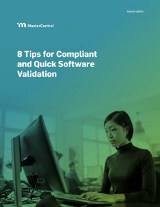
GxP Lifeline
Combatting Counterfeit Medical Devices and Pharmaceuticals: Serialization, Validation, and a Case for Digital Transformation

The manufacture, sales, and distribution of counterfeit medications and medical devices is a persistent and growing problem worldwide. A 2020 INTERPOL operation highlighted this fact and underscored the complex collaboration required to deal with it effectively. Operation Pangea XIII involved 90 countries and combined cross-border participation from international and regional law enforcement bodies, as well as regulatory authorities.1 Although the successful operation netted more than 120 arrests worldwide and the seizure of tens of thousands of counterfeit products, a market that is now estimated at $200 billion dollars per year in counterfeit prescriptions alone, will continue to attract criminal opportunists as it is expected to grow at approximately 20% per year.2
The financial loss to manufacturers to develop compliant products and adhere to U.S. Food and Drug Administration (FDA) software validation and regulated GxP standards is significant, but the resulting risks to patient health from counterfeit pharmaceuticals and medical devices that neglect software validation for medical device manufacturing can cause adverse long-term consequences or even death.
Ensuring Safe Products in Pharma and Medical Device Manufacturing
Patient safety is the priority, and GxP standards are the measure by which legitimate manufacturers design and produce their products to protect consumers. These are strict protocols to ensure that products are safe, deliver according to their intended use, and maintain a standard of quality during the entire product lifecycle — from manufacture, control, storage, and distribution. All facets of the product manufacturing lifecycle are incorporated, including data integrity and GxP software validation, to ensure adequate electronic record keeping. But for a counterfeit producer operating outside of GxP standards, the illicit profits without the added expense of regulatory protocols are a natural temptation that fuels the trade.
The Serialization Solution
The solution is to implement a serialization program that improves traceability and data integrity, links the back office with entire supply chain, and is based upon a common international standard. Serialization is the key and simply means that a medical device or prescription unit will include the product’s origin, batch number and expiry date. The detail confirms the product’s validity and ensures that substandard drugs or devices can be more easily traced.
Regulatory bodies around the world have not responded in a uniform manner to the problem, however, and are still operating without common standards.3 In 2013, the U.S. adopted the DSCA (Drug Supply Chain Security Act), which is designed to be phased in over a 10-year period. The European Union implemented the FMD (Falsified Medicine Directive) in 2019, which requires serialization and barcoding and employs a centralized database for manufacturers to upload serial numbers for verification. By contrast, the DSCA requires manufacturers to implement serialization at a package level but it does not have a central regulator database yet in the U.S.4
New Challenges Bring New Opportunities for Serialization
As regulators continue to align, pharma and medical manufacturers have a unique opportunity to adopt serialization compliance while positioning themselves for improved operational value by linking their serialization program to a modern enterprise resource planning (ERP) system.5 An enterprise-grade system manages the needs of a serialization effort both internally within the operational confines of the manufacturer and the broader big data networks and supply chain ecosystems.
The benefits of quality, operational efficiency, and traceability are derived from the fact that ERP covers all levels in the serialization process, making implementation easier and more efficient. Not only is there greater visibility within the organization but throughout the entire supply chain as well. Big data ecosystems do require external collaboration - so much so, that companies like SAP have invested in unique collaboration hubs that are specifically designed to improve pharma manufacturing collaboration improvements and compliance.
Combining all these elements within big data networks will deliver products that can be validated and traced across entire supply chain ecosystems internationally. This will ensure improved patient safety from the risks of counterfeit drugs and medical devices while improving business performance.
References:
- "Global operation sees a rise in fake medical products related to COVID-19,” INTERPOL, Mar. 19, 2020.
- "$200 Billion Pharma Counterfeit Drug Market Growing by 20% Per Year,” Kim Overstreet, Healthcare Packaging.
- "Counterfeit Drugs: A Bitter Pill To Swallow,” Richard Howells, Forbes, Oct. 3, 2019.
- Supra note 3.
- "Serialization: Reducing Counterfeit Drugs and Increasing Sales,” Scott Deakins, Pharmaceutical Technology, 45 (8), Aug. 2, 2021.

